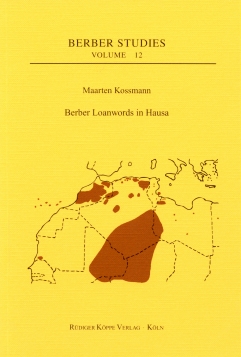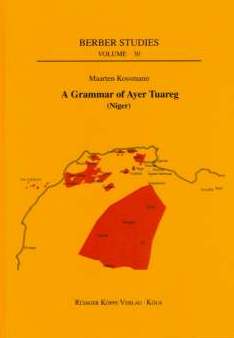

Berber Loanwords in Hausa
Author: Maarten Kossmann. Series edited by: Harry Stroomer.
Series: BS Berber Studies Volume 12
200510 pp. Roman, 228 pp.
2 tables
Text language(s): English
Format: 160 x 240 mm
400 g
Paperback
€ 39.80
Buy 'Berber Loanwords in Hausa' as a downloadable PDF document directly from our online shop »
Order 'Berber Loanwords in Hausa' as print edition »
Hausa is the numerically most important member of the Chadic language family and is spoken by over 35 million people. It is the mayor language of northern Nigeria and southern Niger, nowadays the language of sedentary people. In contrast to that Tuareg, a Berber language, is mostly a nomad’s language.
Linguistic contacts between Tuareg and Hausa have not remained unnoticed by previous scholars. The great event in Hausa-Berber studies occurred in the late 1960s and early 1970s, when the Hausaist Claude Gouffé wrote a number of articles concerning Tuareg-Hausa interferences. After Gouffé’s study, the most important contributions to the question of Tuareg loanwords in Hausa were made by Neil Skinner, which culminated in his Hausa Comparative Dictionary (1996).
The present study follows the general lines set out by Gouffé and, to the lesser degree, Skinner. Its core part, chapter III.1, is an analytical list of about one hundred items which are considered certain Tuareg loans in Hausa. This list contains many etymologies already proposed by Gouffé and Skinner, but half of it are new proposals. In chapter III.2, some 50 uncertain etymologies are discussed.
Some groups of etyma, which have specific histories, are studied in a separate chapter (chapter II). This comprises a study of words for domestic animals, which is mainly concerned with the evaluation of proposals by Skinner (1977, 1981), a study of early Islamic loans, a study of Berber loans which entered Hausa through Kanuri, and a special section on the etymon “camel”.
Chapter IV provides an analysis of the ways Tuareg loanwords were integrated to Hausa phonology and morphology. In chapter V, a number of subjects pertaining to Hausa linguistics are treated, which are drawn from the study of Tuareg loanwords, but which go beyond the analysis of loanwords only.
Following these links you will find further publications on Hausa and monographs and contributions to paper collections by the author:
Accompanying material:
- Dialoge, Prosa und Liedtexte aus dem Lehrbuch der Hausa-Sprache (Audio-CD)
(ISBN 978-3-89645-007-4 ) - From Oral Literature to Video
(ISBN 978-3-89645-579-6 ) - Hausa and the Chadic Language Family
(ISBN 978-3-927620-36-0 ) - Hausa Comparative Dictionary
(ISBN 978-3-927620-53-7 ) - Lehrbuch der Hausa-Sprache
(ISBN 978-3-89645-006-7 ) - Lehrbuch der Hausa-Sprache mit Audio-CD
(ISBN 978-3-89645-008-1 )
Cross-reference:
- A Grammar of Ayer Tuareg (Niger)
(ISBN 978-3-89645-930-5 ) - A Grammatical Sketch of Ghadames Berber (Libya)
(ISBN 978-3-89645-940-4 ) - Berberstudien & A Sketch of Siwi Berber (Egypt)
(ISBN 978-3-89645-389-1 ) - Essai sur la phonologie du proto-berbère
(ISBN 978-3-89645-035-7 ) - Études berbères V – Essais sur des variations dialectales et autres articles
(ISBN 978-3-89645-928-2 )
Reviews
Stanislaw Pilaszewicz in Studies of the Department of African Languages and Cultures, 40/2006, 70-73
Václav Blazek in Folia Orientalia, 42/43, 2006/2007, 433-437
| « back | Print version | [top] |
 Books
Books Audio
Audio Biographies
Biographies Series
Series Festschrifts
Festschrifts Journals
Journals